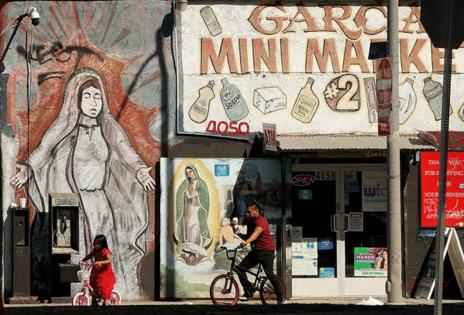The profound environmental health disparities between Latino and white neighborhoods in LA
Published in Health & Fitness
LOS ANGELES — A new data tool from researchers at UCLA highlights significant environmental health disparities between Latino and white neighborhoods in L.A., providing critical insights amid escalating public health concerns linked to the places where climate change and the Trump administration’s recent immigration policy actions intersect.
The Latino Climate and Health Dashboard, developed by UCLA’s Latino Policy and Politics Institute with support from the California Wellness Foundation, consolidates county-specific data on how Latino communities disproportionately suffer from extreme heat and air pollution. It compares Latino-majority (census tracts that have more than 70% Latino residents) and non-Latino white-majority (census tracts that have more than 70% non-Latino white residents) neighborhoods across 23 counties in California. The counties included in the study represent more than 90% of the state’s Latino population.
With California anticipating a particularly hot summer, the dashboard’s data highlight troubling disparities. Latino neighborhoods across California experience approximately 23 more extreme-heat days per year than non-Latino white neighborhoods. The data further reveal that Latino neighborhoods often have more impervious surfaces and older housing stock lacking modern cooling systems, both of which compound the risks of heat exposure. Residents in these communities also frequently hold jobs in outdoor or otherwise heat-exposed industries.
“Extreme heat isn’t just uncomfortable, it’s deadly,” emphasized Irene Burga, a member of the dashboard’s advisory committee and director of the Climate Justice and Clean Air Program at Green Latinos, a national nonprofit. According to Burga, Latino communities in places already burdened by air pollution, inadequate infrastructure and systemic neglect — such as Los Angeles and the Central Valley — face intensified and exacerbated risks.
Designed to be user-friendly and accessible, the dashboard has interactive maps and downloadable county-specific fact sheets. According to the researchers who developed the tool, the design is meant to enable policymakers, community advocates, journalists and researchers easily identify the areas of greatest need.
Anyone can access the information, which includes statistics on extreme heat and fine particulate matter, alongside health outcomes, such as asthma rates and emergency room visits. Users can also cross-reference underlying sociodemographic factors, such as housing quality, tree canopy coverage and employment in heat-exposed industries, to see the environmental effects on various communities.
The results: All of these factors appear to compound environmental health risks for Latinos.
For example, if you click on the “extreme heat” fact sheet for Los Angeles County, you will see a map showing which neighborhoods in the county experience below or above the average number of extreme heat days every year, with Latino neighborhoods highlighted.
The data show that, annually, Latino neighborhoods experience 25 extreme heat days. In similar non-Latino white neighborhoods, that number is only eight.
Another example: In Latino neighborhoods, 4% of land has tree canopy. In non-Latino white neighborhoods, that number is 9% on average.
“Latino communities are on the front lines of climate change, yet they’ve often been left out of the data and decisions that shape public health and environmental policy,” Arturo Vargas Bustamante, a UCLA professor of health policy and management and principal investigator of the project, said in a news release. “This dashboard puts reliable, localized data directly into the hands of policymakers, advocates and residents so they can push for the equitable responses we urgently need.”
Local organizations have welcomed the dashboard as a significant step forward in their advocacy efforts.
“It’s everything that you need right there in a very digestible format,” said Mar Velez, policy director at the Latino Coalition for a Healthy California and a member of the dashboard’s advisory committee. That said, she noted, it’s essential to combine the quantitative analysis the dashboard provides with “the human element.”
Her organization “is really going to be able to leverage the dashboard by bringing those two together,” Velez said. “We’ll be presenting and talking to legislators about [this], as we are continuing to deal with the impacts” of U.S. Immigration and Customs Enforcement raids.
The recent ICE raids in Los Angeles and across California have intensified fears within immigrant communities, which are predominantly Latino. Such fears are preventing individuals from seeking essential medical care, potentially exacerbating existing health disparities in neighborhoods already burdened by environmental hazards.
“Immigrant communities were among the groups that were less likely to use healthcare in general, and we also knew that they lived in areas that were more likely to be exposed to climate change or pollution,” said Bustamante, the UCLA researcher. “This situation has exacerbated the conditions that they experience.”
Velez emphasized the potential effects that can be seen as temperatures rise and ICE raids continue to stoke fear in Latino communities. “People are staying home,” she said. “So, as temperatures increase, as the days get hotter … people are going to continue to stay at home — because they’re scared to go outside, because they’re scared of encountering ICE, then having health issues, heat strokes.”
In a city where air conditioning isn’t mandated in rental units, and cooling centers may not feel accessible or safe, Velez fears what could come next.
“I see this being a huge issue for our community. … We need our legislators to understand that we’re not just dealing with the ICE raids,” Velez said.
The UCLA database, she thinks, can help: “Uncovering and really understanding the layers of impact, I think, is something that I’m really looking forward to in terms of being able to leverage this tool.”
©2025 Los Angeles Times. Visit at latimes.com. Distributed by Tribune Content Agency, LLC.













Comments